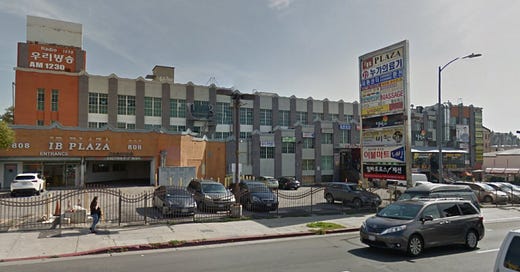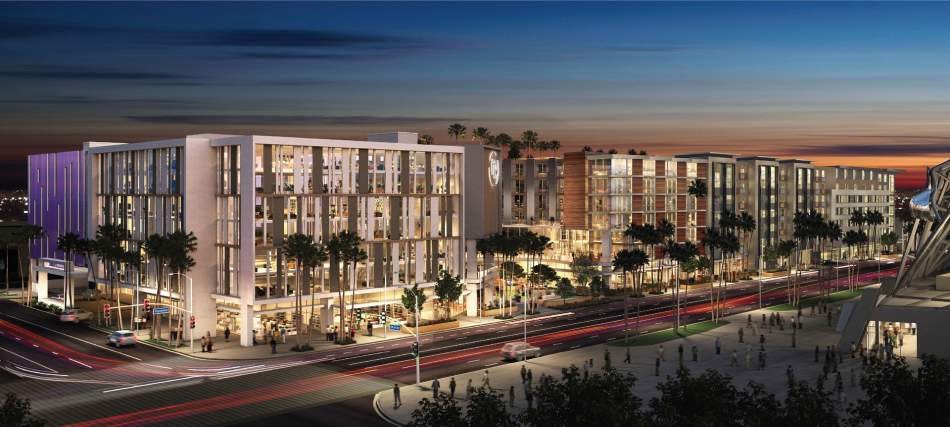I’m not an architect, but in fourth grade I did have to make a model of a California mission. I enlisted my dad to help me with the hot glue gun as I told him where to affix various things onto the base of our replica. I scattered trees throughout the structure, among the many miniature cows, sheep, and caricatures of stout, bald missionaries that I haphazardly dropped into the chapel. We had our mission on our coffee table for a week, stuck to sheets of newspaper underneath to protect the furniture from the ivory paint we splattered while slathering it on the walls of the styrofoam model.
I think of my fourth grade project often when I look at new concept art of new development projects. I cannot make out the species of trees in these renderings. From the top, they remind me of the stringy artificial moss that my dad and I purchased at the arts and crafts store for my mission. The tiny people that artists add into their renderings are seemingly in motion, one foot before the other, but they are expressionless. There are a hundred white fluffy clouds cut and pasted across a neverending blue sky. I’ve never seen Los Angeles that way.
Much of the concept art I see is for projects in Koreatown, where I was raised. It is a neighborhood of working class families and home to one of the largest Salvadoran and Oaxacan populations in Los Angeles, many of whom were here before my Korean predecessors. It’s a delight to traverse and find small businesses with amazing Pakistani dishes, Korean soups, masseuses, and tailors. But concept art for housing projects noticeably leave out the Angelenos who actually use the sidewalks and public transit to walk back home to their rent-controlled one bedroom apartments that are squeezed in between the newer housing projects whose aesthetics get blander by the month.
Maverick Chan is a project manager at The Architects Collective, a firm based in Inglewood. Growing up in the digital age among computer programs like Adobe Illustrator, InkScape, and V-Ray, Chan never knew what it was like to draft by hand; it makes them wonder what life as an architect would have been like long before the industrialization of our cities. Chan also feels as if architects’ works have suffered from the needs and wants of the people who give them the money for their ideas: the developers.
“The whole industry right now is very client-centric,” Chan says. “Our whole profession is predicated on needing a developer to fund our projects, and in order to satisfy that funding requirement, it has to come at the cost of meeting the client's desires and not the architectural desire. Concept art has really suffered in that regard because it's just a serve for marketing purposes now. It's not to serve architecture.”
This change in purpose of concept art has shaped how Chan toes the line when it comes to creating renders for developers. He likens it to “serving a cheeseburger to a kid”: easy-to-consume versus, say, omakase where “they're going to have to learn how to use chopsticks and understand the etiquette of eating sushi.”
“A lot of times, developers don't have the greatest imaginations,” Chan continues. “Those developers who are willing to take risks are hard to find. At the end of the day, the developer just cares about the dollar in their pocket. They don't care how pretty the building looks and what it means to contribute to the urban landscape.”
I used to live near Wilshire and Wiltern, the intersection home to the Wiltern Theater. We know the iconic entertainment venue to be the stunning example of Art Deco architecture that lined the streets of what is now considered Koreatown. The Wiltern is a relic from the 1930’s when the area was inhabited by automobile industry magnates and Hollywood starlets. Architects were excited to draft and design the plan for the theater, which would boast terrazzo paving, decorative plasterwork, and artful murals. According to the Getty Research Institute’s Cultural Objects Name Authority, the venue was painted a blue-green in glazed terracotta tile as “a reminder of the green pastures that previously covered the land.” When I learned this fact, I was struck by the idea of buildings in honor of landscape, buildings that reflect their history.
Two vast blocks down the street from the Wiltern sits an old parking garage and commercial building that used to sell knick knacks and home goods for Korean families. It was also home base to Los Angeles’ longest-running Korean radio station, AM 1230. I’ve looked up at the big radio sign countless times when my mom and I would walk into several of these stores in search of cool summer blankets and fruit trays in the 2000’s. The structure itself was built in the 1920’s and takes on an Art Deco feel with its chevrons and corner pilasters.
By the time I left the Koreatown neighborhood in 2021, the parking garage and building were mostly shuttered, used freely as canvas by graffiti artists. The lot was long considered a blight by developers and Los Angeles’ City Planning Commission. Then in December 2017, the Planning Commission enthusiastically endorsed plans to erect a hotel, apartments, and shops on the plot. When I saw this announcement, I had to look at what commanded such approval.
I first noticed the heavy use of glass, a fragile material to use in gritty Koreatown. The new development also turned the chevron patterns into rust red columns. A white PARKING sign replaced the familiar Radio 1230 sign. The weather in this initial concept art of the 800 Western project was sharp and clear, as if the future will be migraine-bright.
Whereas the new 800 Western concept contains market rate housing, Chan’s architect firm focuses primarily on affordable housing. Chan tries to use different kinds of people in his renderings to show how the space will be used. Then they include planting and foliage based on contextual photographs of the site. They don’t like to change anything or show anything that doesn’t already exist around the space. Because client relationships demand efficiency, Chan doesn’t have the time to care about the way the sun will hit someone’s balcony during sunset, but they also don't feel discouraged by this truth about concept art.
“God is in the details and that the architecture doesn't stop at concept art,” they say. “It continues on through construction and every decision I make in each detail of how it's getting put together that is at a tangible level, at a human scale, what people will be interacting with with my work.”
I’ve had my eye on a major mixed-use project just a few neighborhoods away from Koreatown. Currently titled Exposition Point, the 4.4 acre development would demolish a large community of rent-stabilized units to make way for 435 apartments and 23,700 square feet of shops and restaurants. It would be situated near the Los Angeles Memorial Coliseum, BMO Stadium, and University of Southern California, where many low income families reside at odds with the private institutions that threaten their homes with large-scale sports and entertainment complexes. A developer’s vision for projects like Exposition Point is to create a Los Angeles that the wealthy can ogle for years to come, especially with the World Cup and the Olympics looming over us.
The concept art for Exposition Point promises a housing development for students and families while also offering places for tourists and traveling athletes. Everyone is fenced in by alabaster-white and corporate-gray panels. In the rendering, a dusky sunset vies with the yellow glow from the dull, glassy building. There are cars, presumably, that dot the roads. When I squint, all I see are the grays, purples, whites, and greens that I don’t naturally see in the real world. There are dozens of random palm trees. There are figures standing on the block, faceless and a few of whom are peering into a glowing building that harbors nobody inside. That’s the thing, isn’t it? No one lives inside concept art.
I have been effectively priced out of Koreatown. To pay $2,300 for a one bedroom inside a characterless, cubicle-inspired box is absurd. I moved back in with my parents, who live in Glendale farther away from the hotbed of heartless property investments, although it’s definitely creeping over here, too. But the bees still pollinate the honeysuckle bushes in my neighbor’s front yard in the spring. The squirrel that watches me work through the window that faces its lush green laurel sumac. In fact, it’s the same squirrel that nips at my mom’s ankles, asking for the walnuts she occasionally leaves for it on our front steps, when she ambles over to the laundry room. In the wintertime the very pregnant lemon tree still drops its fruit, which rolls over to our side of the building; my mom asks if I could pilfer them from the neighbor. This is the same neighbor whose youngest daughter squeals “Hiiiiii” and runs into my mom’s legs for an embrace when we see them in the garage. Render me this.
………………
LISA KWON is a writer and reporter born, raised, and based in Los Angeles, CA. Bylines include Teen Vogue, Vulture, L.A. Taco, Eater, Vice, PAPER, and many more. She loves birding, the Dodgers, and the ongoing pizza renaissance in L.A.
………………
DON’T FORGET TO PRE-ORDER YOUR COPY OF CUSPER ISSUE #3 ‘TREASURE & TRASH’ + RSVP TO OUR COMEDY SHOW DEC 13th.
and use code: ‘CUSPER3’ for $5 off.
………………








